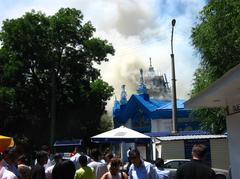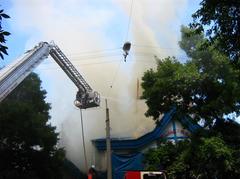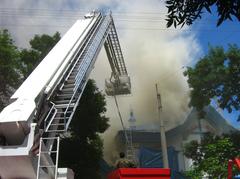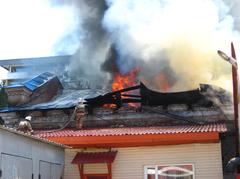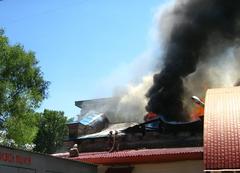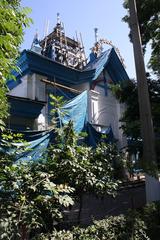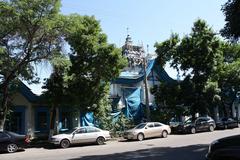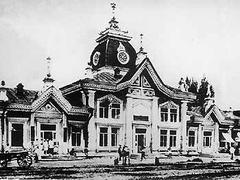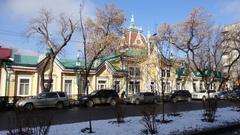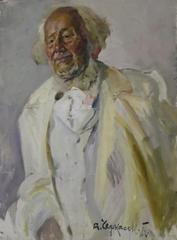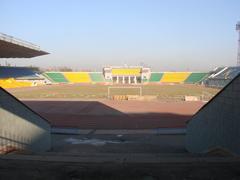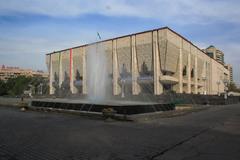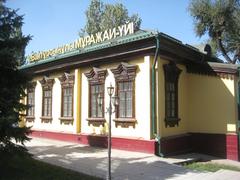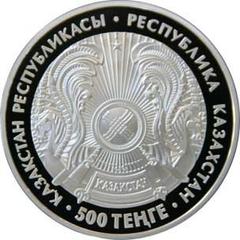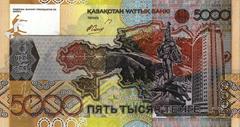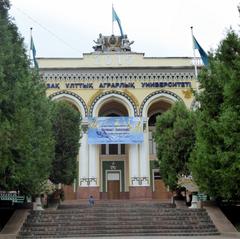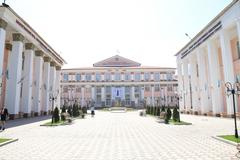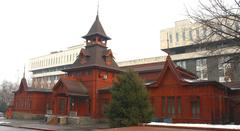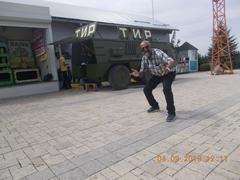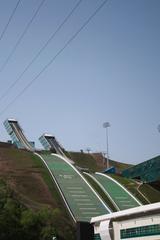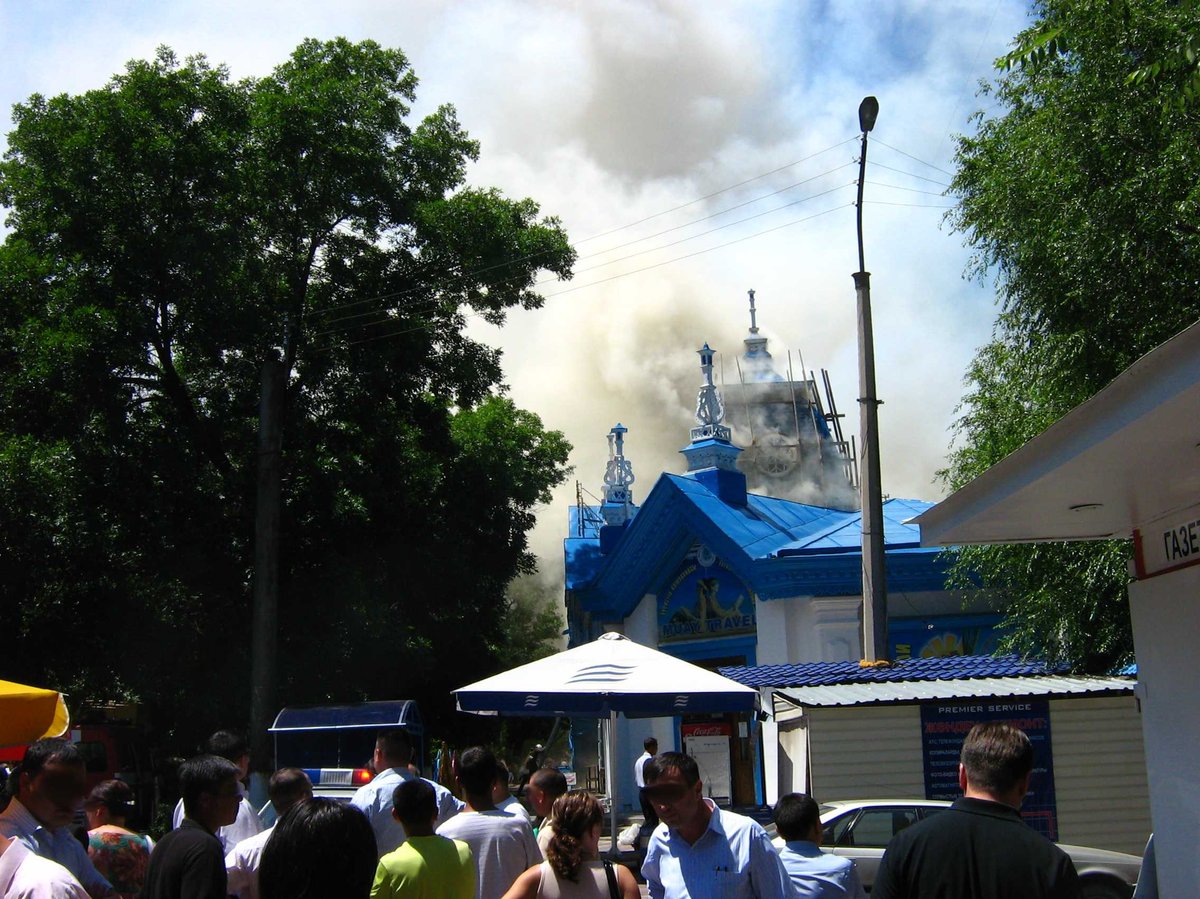
Kyzyl-Tan Visiting Hours, Tickets, and Almaty Historical Sites Guide
Date: 15/06/2025
Introduction
Kyzyl-Tan, a standout historical and architectural landmark in Almaty, Kazakhstan, captures the city’s layered past and rich cultural evolution. Originally the Verny Trading House, Kyzyl-Tan’s neo-Russian design, vibrant canary-yellow façade, and ornate woodwork have made it a symbol of Almaty’s transformation from a Silk Road outpost to a dynamic metropolis. Its blend of Russian and Kazakh craftsmanship, resilience through earthquakes and urban renewal, and enduring role as a commercial hub make Kyzyl-Tan an essential stop for history buffs, architecture enthusiasts, and cultural travelers alike (welcome.kz, tmatic.travel). This comprehensive guide provides historical context, practical visitor tips, and recommendations for exploring Kyzyl-Tan and neighboring Almaty attractions.
Historical and Architectural Overview
Early Origins and Urban Context
Constructed in the late 19th or early 20th century, Kyzyl-Tan is widely attributed to architect P.V. Gourde, with some sources also crediting A.P. Zenkov (tmatic.travel). The building is a rare example of neo-Russian architecture in Central Asia, featuring a one-story wooden mansion with a brick base, symmetrical façade, central tower crowned by an ornate dome and spire, and intricate decorative woodwork.
Kyzyl-Tan’s design exemplifies the ambitions of Almaty’s merchant class and reflects architectural trends of the Russian Empire, while also adopting local techniques for earthquake resilience. Its rectangular floor plan, relief cornices, and applied thread valances showcase both Russian decorative motifs and skilled local craftsmanship.
Historical Significance
Located on Zhibek Zholy Street, a vital artery of commerce historically known as the “Silk Road,” Kyzyl-Tan was a center of trade and urban activity during Almaty’s rapid growth after the 1887 earthquake (astanatimes.com). The building survived major disasters, including the 1911 earthquake and a fire in 2009, thanks to its robust construction and timely restoration efforts (welcome.kz). In 1982, it was designated a monument of national historical and cultural importance.
Ownership and Evolving Function
Initially a trading house for merchant I. Gabdulvaliev, Kyzyl-Tan was nationalized and repurposed by Soviet authorities, renamed “Kyzyl-Tang” (Red Sign/Red Dawn), and used for administrative and commercial purposes. Throughout these changes, the building’s core character remained intact, continuing its legacy as a commercial and cultural hub (tmatic.travel).
Kyzyl-Tan Today: Visitor Experience and Practical Information
Location and Access
- Address: 45 Valikhanov Street (also near 39 Zhibek Zholy Street), Almaty
- Getting There: Easily accessible via public buses, taxis, and rideshare services like Yandex Go and Uber. The pedestrian-friendly Arbat (Zhibek Zholy Street) and proximity to Green Bazaar and Panfilov Park enhance the visitor experience (exploretraveloasis.com).
Visiting Hours and Tickets
- Opening Hours: Daily, 10:00 AM – 7:00 PM (welcome.kz)
- Entrance Fee: Free for general entry as an active commercial space. Guided tours may require a ticket, typically 500–1000 KZT, available on-site or through local tour operators.
- Accessibility: The building features ramps and accessible pathways. The surrounding pedestrian area is also accessible.
Visitor Tips
- Best Time to Visit: Spring (April–June) and autumn (September–October) offer mild weather and clear views.
- What to Bring: Comfortable shoes for walking; basic Russian phrases or a translation app; cash for markets; bottled water.
- Safety: Almaty is generally safe, but standard travel precautions are advised.
- Connectivity: Wi-Fi is available in hotels and many cafés; SIM cards can be purchased at the airport and in the city.
Kyzyl-Tan in Almaty’s Architectural and Cultural Landscape
Architectural Highlights
Kyzyl-Tan stands out for its harmonious blend of Russian neo-classical and vernacular motifs, evidenced in its double-height tower, domed roof, and ornate woodwork. Restoration efforts have preserved its visual impact and cultural value, making it a cherished landmark amid the city’s Soviet-era and modernist buildings (e-a-a.com).
Social and Cultural Role
As a living commercial hub, Kyzyl-Tan supports local artisans and crafters, maintaining Almaty’s vibrant marketplace tradition. The building’s central location makes it a focal point for cultural events, festivals, and street performances in the nearby Arbat zone (exploretraveloasis.com).
Symbolism
Kyzyl-Tan’s survival through natural disasters and political changes embodies Almaty’s resilience and adaptability, bridging the city’s historic roots and contemporary identity (welcome.kz).
Exploring Almaty: Nearby Historical Sites and Attractions
Key Landmarks Near Kyzyl-Tan
- Green Bazaar: Traditional market, open 7:00 AM – 6:00 PM, free entry.
- Zenkov Cathedral (Ascension Cathedral): Wooden architectural marvel, open 10:00 AM – 6:00 PM, ~500 KZT entry (bucketlistly.blog).
- Central State Museum of Kazakhstan: Largest museum in Central Asia, open Tuesday–Sunday, 10:00 AM – 6:00 PM (e-a-a.com).
- Kok-Tobe Hill: Panoramic views, accessible by cable car (oneintheorangejacket.com).
- Medeu Skating Rink: Famous outdoor skating venue (astanatimes.com).
Nature and Urban Harmony
Almaty’s proximity to the Trans-Ili Alatau mountains and integration of green spaces into urban design provide stunning backdrops and a high quality of life for residents and visitors (gokite.travel).
Accommodation
- Budget: Hostels from $10–$20 (e.g., Wanderlust Hostel Riverside).
- Mid-range: Apartments or boutique hotels from $30–$50 (e.g., Evergreen Apart).
- Luxury: International hotels like The Ritz-Carlton Almaty, Hotel Kazakhstan.
- Booking Tips: Reserve early during peak seasons (June–September, December–February).
Dining and Cuisine
Enjoy traditional Kazakh dishes such as beshbarmak, plov, and shashlik at local cafés and restaurants near Kyzyl-Tan. The area also offers a lively bar and coffeehouse scene (exploretraveloasis.com).
Essential Travel Information
- Language: Russian is widely spoken; English is limited.
- Currency: Kazakhstani tenge (KZT); cash is preferred in markets.
- Dress Code: Modest attire in religious sites; casual Western dress elsewhere.
- Health: Drink bottled water; modern hospitals are accessible.
Frequently Asked Questions (FAQ)
Q: What are Kyzyl-Tan’s visiting hours?
A: Daily, 10:00 AM – 7:00 PM (welcome.kz).
Q: Is there an entrance fee?
A: General entry is free; guided tours may require a ticket.
Q: Is Kyzyl-Tan accessible for people with disabilities?
A: Yes, with ramps and accessible pathways.
Q: What other historical sites are nearby?
A: Green Bazaar, Panfilov Park, Zenkov Cathedral, Museum of Almaty, and the Arbat pedestrian zone.
Q: How do I get there from the airport?
A: Use taxis, rideshare apps, or public buses from Almaty International Airport, 25 km from the city center.
Visuals and Media
Include high-resolution images of Kyzyl-Tan’s façade, interior woodwork, and surrounding landmarks, all with descriptive alt text for accessibility and SEO. Interactive maps and virtual tours further enhance the visitor experience.
Useful Contacts and Resources
- Tourist Information: Almaty official tourism website.
- Emergency Numbers: 112 (general), 101 (fire), 102 (police), 103 (ambulance).
- Apps: Yandex Go for transport, Google Translate, local weather apps.
Conclusion and Call to Action
Kyzyl-Tan is more than an architectural gem; it is a living testament to Almaty’s resilience and cultural synthesis. Whether you’re captivated by history, architecture, or vibrant city life, a visit to Kyzyl-Tan promises an enriching experience. For the latest updates, guided tours, and practical travel tips, download the Audiala app and follow our social media channels. Embrace the opportunity to explore Kyzyl-Tan and Almaty’s historic heart—plan your visit today!
